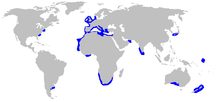Bramble shark
| Bramble shark | |
|---|---|

| |
| Echinorhinus brucus, illustration of the zoology of South Africa (1838) | |

| |
| Echinorhinus brucus, mounted specimen. | |
| Scientific classification | |
| Domain: | Eukaryota |
| Kingdom: | Animalia |
| Phylum: | Chordata |
| Class: | Chondrichthyes |
| Subclass: | Elasmobranchii |
| Subdivision: | Selachimorpha |
| Order: | Squaliformes |
| Family: | Echinorhinidae |
| Genus: | Echinorhinus |
| Species: | E. brucus
|
| Binomial name | |
| Echinorhinus brucus (Bonnaterre, 1788)
| |

| |
| Range of the bramble shark[2] | |
| Synonyms | |
|
Echinorhinus mccoyi Whitley, 1931
| |
The bramble shark (Echinorhinus brucus) is one of the two
The diet of the bramble shark includes smaller sharks,
Taxonomy
The original description of the bramble shark was authored by French
Description
The bramble shark has a thick, cylindrical body and a somewhat flattened head. The snout is blunt and shorter than the width of the mouth, with widely spaced nostrils that are preceded by small flaps of skin. The eyes lack nictitating membranes; the tiny spiracles are located well behind them. The wide, curved mouth bears very short furrows at the corners. There are 20–26 upper and 22–26 lower tooth rows; each tooth is knife-like, with a single main cusp and up to three cusplets on either side. There are five pairs of gill slits, with the fifth pair the longest.[5][8]
The
The skin is covered by a layer of foul-smelling
Distribution and habitat
Records of the bramble shark are fairly rare and originate from widely scattered locations in
Found close to the
Biology and ecology


Sluggish in nature, the bramble shark feeds on smaller sharks (including the
Human interactions
The bramble shark is not known to pose a danger to humans. It is
References
- ^ . Retrieved 19 November 2021.
- ^ ISBN 978-0-691-12072-0.
- ^ Bonnaterre, J.P. (1788). Tableau encyclopédique et methodique des trois règnes de la nature... Ichthyologie. Panckoucke. p. 11.
- ^ ISBN 978-0-19-539294-4.
- ^ ISBN 92-5-101384-5.
- ^ Blainville, H. de (1816). "Prodrome d'une nouvelle distribution systématique du règne animal". Bulletin de la Société Philomathique de Paris. 8: 105–112.
- ^ a b Froese, R.; Pauly, D. (eds). "Echinorhinus brucus". FishBase. March 2012 Version. Downloaded on March 24, 2012.
- ISBN 978-0-292-75206-1.
- ^ a b c Kabasakal, H.; Oz, M.I.; Karhan, S.U.; Caylarbasi, Z.; Tural, U. (2005). "Photographic evidence of the occurrence of bramble shark, Echinorhinus brucus (Bonnaterre, 1788) (Squaliformes: Echinorhinidae) from the Sea of Marmara" (PDF). Annales Series Historia Naturalis. 15 (1): 51–56. Archived from the original (PDF) on 2013-09-27. Retrieved 2012-03-25.
- ^ Martin, R.A. "Echinorhiniformes: Bramble Sharks". ReefQuest Centre for Shark Research. Downloaded on March 24, 2012.
- ISBN 978-0-8018-6048-5.
- .
- ISBN 978-0-674-03411-2.
- ^ a b Joel, J.J.; Ebenzer, I.P. (1991). "On a bramble shark with 52 embryos" (PDF). Indian Council of Agricultural Research Marine Fisheries Information Service Technical and Extension Series (Suppl. 108): 15, 31.
- ^ Silas, E.G.; Selvaraj, G.S.D. (1972). "Descriptions of the adult and embryo of the bramble shark Echinorhinus brucus (Bonnaterre) obtained from the continental slope of India" (PDF). Journal of the Marine Biological Association of India. 14 (1): 395–401.
- OCLC 1042901090.
External links
- "Echinorhinus brucus Bramble shark" at FishBase
- "Biological Profiles: Bramble Shark" at Florida Museum of Natural History






